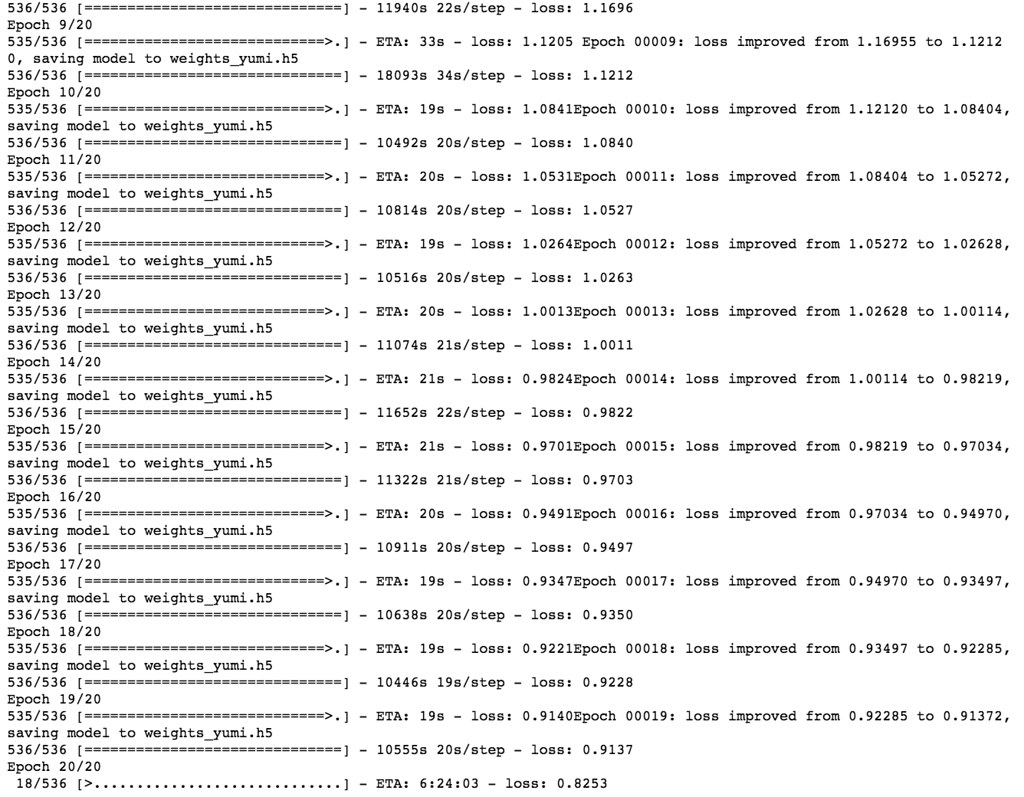This is the fifth blog post of Object Detection with YOLO blog series. This blog finally train the model using the scripts that are developed in the previous blog posts. I will use PASCAL VOC2012 data. This blog assumes that the readers have read the previous blog posts - Part 1, Part 2, Part 3, Part 4.
Andrew Ng's YOLO lecture¶
- Neural Networks - Bounding Box Predictions
- C4W3L06 Intersection Over Union
- C4W3L07 Nonmax Suppression
- C4W3L08 Anchor Boxes
- C4W3L09 YOLO Algorithm
Reference¶
Reference in my blog¶
- Part 1 Object Detection using YOLOv2 on Pascal VOC2012 - anchor box clustering
- Part 2 Object Detection using YOLOv2 on Pascal VOC2012 - input and output encoding
- Part 3 Object Detection using YOLOv2 on Pascal VOC2012 - model
- Part 4 Object Detection using YOLOv2 on Pascal VOC2012 - loss
- Part 5 Object Detection using YOLOv2 on Pascal VOC2012 - training
- Part 6 Object Detection using YOLOv2 on Pascal VOC 2012 data - inference on image
- Part 7 Object Detection using YOLOv2 on Pascal VOC 2012 data - inference on video
My GitHub repository¶
This repository contains all the ipython notebooks in this blog series and the funcitons (See backend.py).
import matplotlib.pyplot as plt
import numpy as np
import os, sys
import tensorflow as tf
print(sys.version)
%matplotlib inline
Define anchor box¶
ANCHORS defines the number of anchor boxes and the shape of each anchor box.
The choice of the anchor box specialization is already discussed in Part 1 Object Detection using YOLOv2 on Pascal VOC2012 - anchor box clustering.
Based on the K-means analysis in the previous blog post, I will select 4 anchor boxes of following width and height. The width and heights are rescaled in the grid cell scale (Assuming that the number of grid size is 13 by 13.) See Part 2 Object Detection using YOLOv2 on Pascal VOC2012 - input and output encoding to learn how I rescal the anchor box shapes into the grid cell scale.
Here I choose 4 anchor boxes. With 13 by 13 grids, every frame gets 4 x 13 x 13 = 676 bouding box predictions.
ANCHORS = np.array([1.07709888, 1.78171903, # anchor box 1, width , height
2.71054693, 5.12469308, # anchor box 2, width, height
10.47181473, 10.09646365, # anchor box 3, width, height
5.48531347, 8.11011331]) # anchor box 4, width, height
Define Label vector containing 20 object classe names.¶
LABELS = ['aeroplane', 'bicycle', 'bird', 'boat', 'bottle',
'bus', 'car', 'cat', 'chair', 'cow',
'diningtable','dog', 'horse', 'motorbike', 'person',
'pottedplant','sheep', 'sofa', 'train', 'tvmonitor']
Read images and annotations into memory¶
Use the pre-processing code for parsing annotation at experiencor/keras-yolo2.
This parse_annoation function is already used in Part 1 Object Detection using YOLOv2 on Pascal VOC2012 - anchor box clustering and saved in my python script.
This script can be downloaded at my Github repository, FairyOnIce/ObjectDetectionYolo/backend.
### The location where the VOC2012 data is saved.
train_image_folder = "../ObjectDetectionRCNN/VOCdevkit/VOC2012/JPEGImages/"
train_annot_folder = "../ObjectDetectionRCNN/VOCdevkit/VOC2012/Annotations/"
np.random.seed(1)
from backend import parse_annotation
train_image, seen_train_labels = parse_annotation(train_annot_folder,
train_image_folder,
labels=LABELS)
print("N train = {}".format(len(train_image)))
Instantiate batch generator object¶
SimpleBatchGenerator is discussed and used in
Part 2 Object Detection using YOLOv2 on Pascal VOC2012 - input and output encoding.
This script can be downloaded at my Github repository, FairyOnIce/ObjectDetectionYolo/backend.
from backend import SimpleBatchGenerator
BATCH_SIZE = 200
IMAGE_H, IMAGE_W = 416, 416
GRID_H, GRID_W = 13 , 13
TRUE_BOX_BUFFER = 50
BOX = int(len(ANCHORS)/2)
generator_config = {
'IMAGE_H' : IMAGE_H,
'IMAGE_W' : IMAGE_W,
'GRID_H' : GRID_H,
'GRID_W' : GRID_W,
'LABELS' : LABELS,
'ANCHORS' : ANCHORS,
'BATCH_SIZE' : BATCH_SIZE,
'TRUE_BOX_BUFFER' : TRUE_BOX_BUFFER,
}
def normalize(image):
return image / 255.
train_batch_generator = SimpleBatchGenerator(train_image, generator_config,
norm=normalize, shuffle=True)
Define model¶
We define a YOLO model. The model defenition function is already discussed in Part 3 Object Detection using YOLOv2 on Pascal VOC2012 - model and all the codes are available at my Github.
from backend import define_YOLOv2, set_pretrained_weight, initialize_weight
CLASS = len(LABELS)
model, true_boxes = define_YOLOv2(IMAGE_H,IMAGE_W,GRID_H,GRID_W,TRUE_BOX_BUFFER,BOX,CLASS,
trainable=False)
model.summary()
Initialize the weights¶
The initialization of weights are already discussed in Part 3 Object Detection using YOLOv2 on Pascal VOC2012 - model. All the codes from Part 3 are stored at my Github.
path_to_weight = "./yolov2.weights"
nb_conv = 22
model = set_pretrained_weight(model,nb_conv, path_to_weight)
layer = model.layers[-4] # the last convolutional layer
initialize_weight(layer,sd=1/(GRID_H*GRID_W))
Loss function¶
We already discussed the loss function of YOLOv2 implemented by experiencor/keras-yolo2 in Part 4 Object Detection using YOLOv2 on Pascal VOC2012 - loss. I modified the codes and the codes are available at my Github.
from backend import custom_loss_core
help(custom_loss_core)
Notice that this custom function custom_loss_core depends not only on y_true and y_pred but also the various hayperparameters.
Unfortunately, Keras's loss function API does not accept any parameters except y_true and y_pred. Therefore, these hyperparameters need to be defined globaly.
To do this, I will define a wrapper function custom_loss.
GRID_W = 13
GRID_H = 13
BATCH_SIZE = 34
LAMBDA_NO_OBJECT = 1.0
LAMBDA_OBJECT = 5.0
LAMBDA_COORD = 1.0
LAMBDA_CLASS = 1.0
def custom_loss(y_true, y_pred):
return(custom_loss_core(
y_true,
y_pred,
true_boxes,
GRID_W,
GRID_H,
BATCH_SIZE,
ANCHORS,
LAMBDA_COORD,
LAMBDA_CLASS,
LAMBDA_NO_OBJECT,
LAMBDA_OBJECT))
Training starts here!¶
Finally, we start the training here. We only train the final 23rd layer and freeze the other weights. This is because I am unfortunately using CPU environment.
from keras.callbacks import EarlyStopping, ModelCheckpoint
from keras.optimizers import SGD, Adam, RMSprop
dir_log = "logs/"
try:
os.makedirs(dir_log)
except:
pass
BATCH_SIZE = 32
generator_config['BATCH_SIZE'] = BATCH_SIZE
early_stop = EarlyStopping(monitor='loss',
min_delta=0.001,
patience=3,
mode='min',
verbose=1)
checkpoint = ModelCheckpoint('weights_yolo_on_voc2012.h5',
monitor='loss',
verbose=1,
save_best_only=True,
mode='min',
period=1)
optimizer = Adam(lr=0.5e-4, beta_1=0.9, beta_2=0.999, epsilon=1e-08, decay=0.0)
#optimizer = SGD(lr=1e-4, decay=0.0005, momentum=0.9)
#optimizer = RMSprop(lr=1e-4, rho=0.9, epsilon=1e-08, decay=0.0)
model.compile(loss=custom_loss, optimizer=optimizer)
model.fit_generator(generator = train_batch_generator,
steps_per_epoch = len(train_batch_generator),
epochs = 50,
verbose = 1,
#validation_data = valid_batch,
#validation_steps = len(valid_batch),
callbacks = [early_stop, checkpoint],
max_queue_size = 3)
FairyOnIce/ObjectDetectionYolo contains this ipython notebook and all the functions that I defined in this notebook.
By accident, I stopped a notebook. Here, let's resume the training..
model.load_weights('weights_yolo_on_voc2012.h5')
model.fit_generator(generator = train_batch_generator,
steps_per_epoch = len(train_batch_generator),
epochs = 50,
verbose = 1,
#validation_data = valid_batch,
#validation_steps = len(valid_batch),
callbacks = [early_stop, checkpoint],
max_queue_size = 3)
